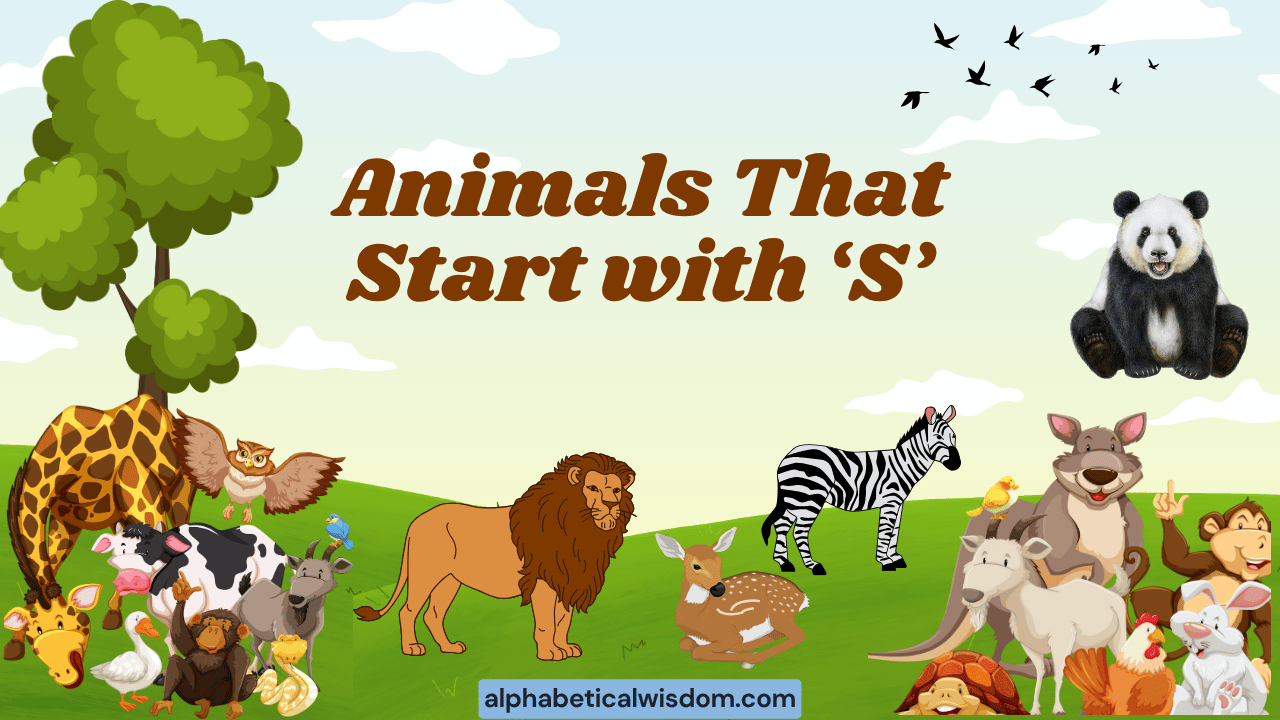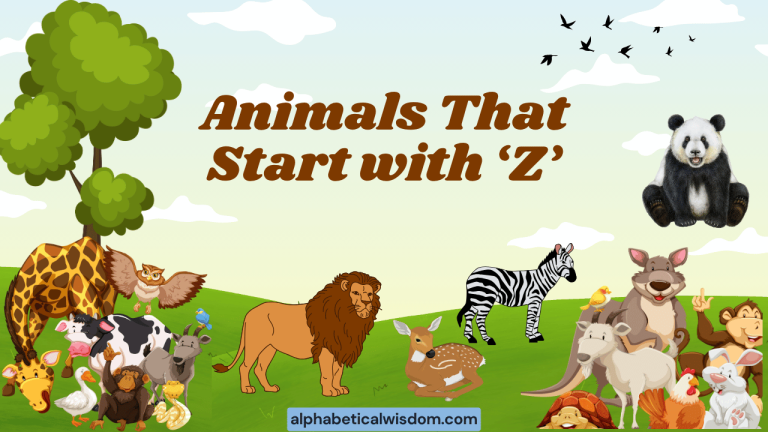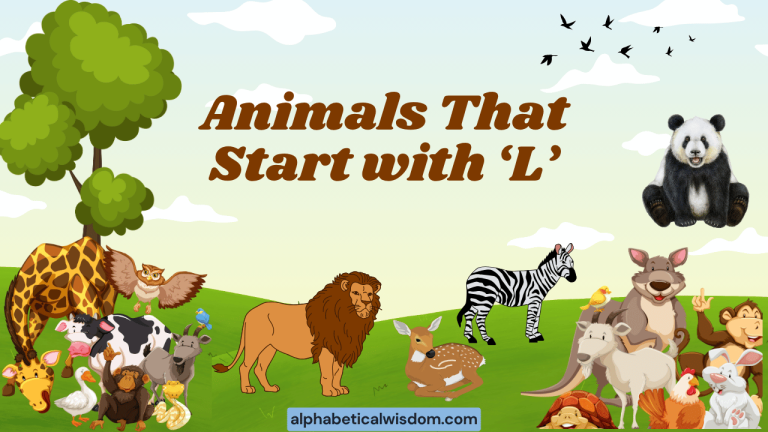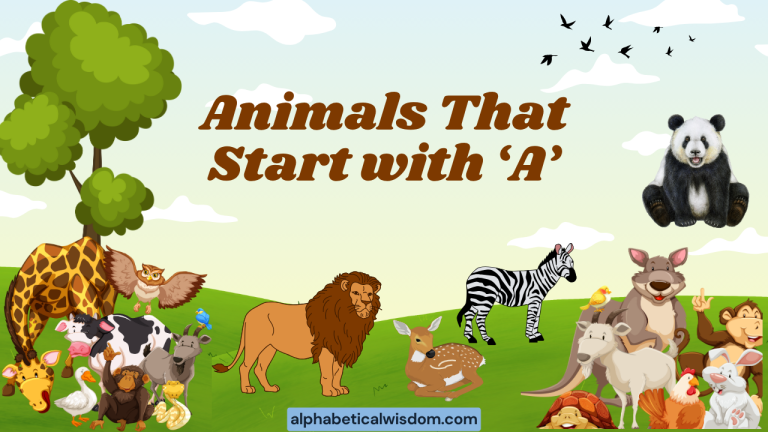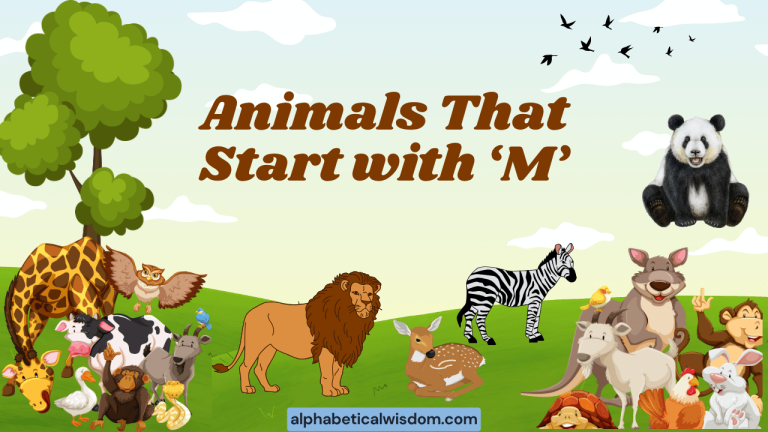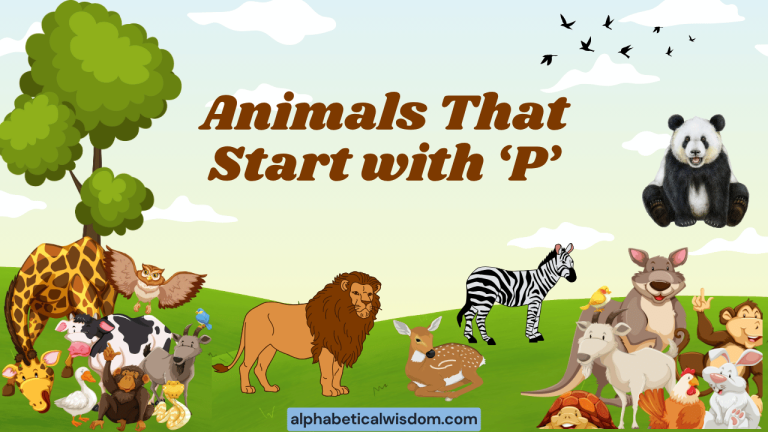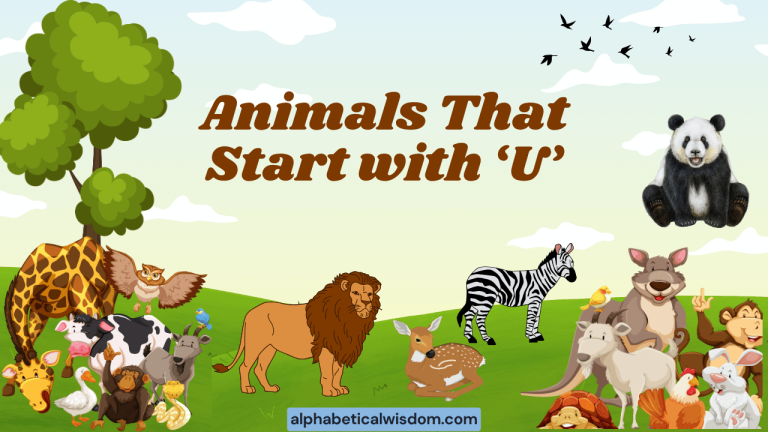Animals That Start With S: A Grammatical and Zoological Exploration
Exploring animals that begin with the letter “S” offers a fascinating intersection of zoology and English grammar. This topic is essential for expanding vocabulary, understanding noun classifications (common vs. proper), and appreciating the diversity of the animal kingdom.
Students learning English as a second language, young learners building their vocabulary, and anyone with an interest in animals will find this article beneficial. By examining these animal names, we can reinforce grammatical principles and deepen our knowledge of the natural world, making language learning both engaging and informative.
Table of Contents
- Introduction
- Definition: Nouns and Animal Names
- Structural Breakdown of Animal Names
- Types of Animal Names
- Examples of Animals That Start With S
- Usage Rules for Animal Names
- Common Mistakes with Animal Names
- Practice Exercises
- Advanced Topics
- FAQ
- Conclusion
Definition: Nouns and Animal Names
In grammar, a noun is a word that represents a person, place, thing, or idea. Animal names, specifically, fall under the category of nouns. They identify and refer to different species and individual creatures within the animal kingdom. Understanding how to use these nouns correctly is crucial for clear and accurate communication.
Animal names can be further classified into two main types: common nouns and proper nouns. Common nouns refer to general categories of animals (e.g., snake, squirrel, shark), while proper nouns refer to specific, named animals (e.g., Sammy the snake, Squeaky the squirrel). Proper nouns are always capitalized, whereas common nouns are only capitalized at the beginning of a sentence or in titles.
Animal names function as subjects, objects, complements, or appositives within sentences. Their role depends on the context and the grammatical structure of the sentence.
For example, in the sentence “The snake slithered through the grass,” “snake” functions as the subject.
Structural Breakdown of Animal Names
The structure of animal names is relatively straightforward. Most animal names consist of a single word (e.g., seal, swan, spider). However, some names may consist of two or more words, often combining descriptive terms with a base noun (e.g., sea lion, snow leopard, swallowtail butterfly). These multi-word names function as a single noun phrase.
Animal names can also be modified by adjectives to provide more specific information. For instance, “a slithering snake” or “a spotted salamander.” Adjectives enhance the description and create a more vivid image.
Understanding the grammatical gender of animal names is also important, though less prominent in English compared to some other languages. Generally, animal names are treated as neuter unless the gender is known and relevant (e.g., “The hen laid an egg”; “The rooster crowed loudly”).
Pronouns like “it,” “he,” or “she” are used accordingly.
Types of Animal Names
Common Names
Common names are the everyday names used to refer to animals. These names are generally understood within a particular language or region. Examples include squirrel, seal, shark, and swan. Common names are typically written in lowercase unless they begin a sentence or are part of a title.
Common names can sometimes be ambiguous, as different regions might use the same name for different animals, or different names for the same animal. This is why scientific names are important for precise identification.
Scientific Names
Scientific names, also known as binomial nomenclature, provide a standardized and universally recognized way to identify animals. These names consist of two parts: the genus (capitalized) and the species (lowercase). Both parts are usually italicized. For example, the scientific name for the domestic cat is Felis catus, and for the gray wolf is Canis lupus. The scientific name for the American robin is Turdus migratorius.
Scientific names are crucial in scientific research and communication, ensuring that everyone is referring to the same animal regardless of their native language. They provide a level of precision that common names often lack.
Collective Nouns for Animals
Collective nouns are used to refer to a group of animals. These nouns can add richness and color to language when describing animals in groups. Some examples of collective nouns for animals that start with “S” include: a sloth of bears, a swarm of bees, a school of fish, a sedge of bitterns (heron-like birds), and a stable of horses (though not all start with ‘S’, it’s relevant to animal groups). Also, a sleuth of bears refers to a group of bears.
Understanding collective nouns helps to describe groups of animals more vividly and accurately. While some collective nouns are more common, others are quite rare and may sound archaic, adding a unique flavor to writing.
Examples of Animals That Start With S
Mammals
Here are some examples of mammals that start with the letter “S.” Mammals are warm-blooded vertebrates characterized by the presence of mammary glands in females, hair or fur, and three middle ear bones.
| Animal | Description | Habitat |
|---|---|---|
| Seal | Aquatic mammal with flippers; known for their blubber. | Arctic and Antarctic regions, coastal waters. |
| Sea Lion | Large marine mammal with external ear flaps; related to seals. | Coastal areas of the Pacific and Atlantic Oceans. |
| Sheep | Domesticated ruminant mammal raised for wool, meat, and milk. | Farms and grasslands worldwide. |
| Squirrel | Small rodent with a bushy tail; often seen in trees. | Forests, parks, and gardens. |
| Shrew | Small, mouse-like mammal with a long snout; insectivorous. | Various habitats, including forests, grasslands, and wetlands. |
| Sloth | Slow-moving arboreal mammal; spends most of its life in trees. | Tropical rainforests of Central and South America. |
| Stoat | Also known as an ermine; a small, carnivorous mammal with a long body. | Europe, Asia, and North America. |
| Sable | Small carnivorous mammal valued for its dark fur. | Forests of Russia, Siberia, and Mongolia. |
| Springbok | Medium-sized antelope native to southern Africa; known for its pronking. | Southern Africa grasslands. |
| Sifaka | A type of lemur found in Madagascar known for its unique way of moving that resembles dancing. | Madagascar |
| Sea Otter | Marine mammal native to the coasts of the northern and eastern North Pacific Ocean. | North Pacific Ocean. |
| Spotted Hyena | Carnivorous mammal known for its distinctive call and social behavior. | Sub-Saharan Africa. |
| Sugar Glider | Small, arboreal gliding possum native to Australia and New Guinea. | Australia and New Guinea. |
| Saki Monkey | New World monkey found in South America. | South America. |
| Sambar Deer | Large deer native to the Indian subcontinent, South China, and Southeast Asia. | Asia. |
| Shetland Pony | Small, sturdy breed of pony originating from the Shetland Isles of Scotland. | Shetland Isles of Scotland. |
| Sitatunga | Semi-aquatic antelope found in swampy areas of central Africa. | Central Africa. |
| Spectacled Bear | Also known as the Andean bear, it is the only bear native to South America. | South America. |
| Striped Skunk | North American mammal known for its distinctive black and white stripes and defensive spray. | North America. |
| Sumatran Rhinoceros | Rare species of rhinoceros found in Sumatra and Borneo. | Sumatra and Borneo. |
| Snowshoe Hare | Hare adapted to cold environments with large hind feet for movement on snow. | North America. |
| Saola | Rare bovine found in the Annamite Range of Vietnam and Laos. | Vietnam and Laos. |
| Sei Whale | Baleen whale found in all oceans except the Arctic and Antarctic. | Worldwide. |
| Spider Monkey | Agile monkey with long limbs and a prehensile tail. | Central and South America. |
The table above lists various mammals that start with the letter “S,” along with their descriptions and habitats. This provides a quick reference for expanding your knowledge of animal names and their characteristics.
The diversity of these mammals highlights the wide range of habitats and adaptations found within this class of animals.
Reptiles
Reptiles are cold-blooded vertebrates characterized by scales, laying eggs (usually), and breathing air. Here are some examples of reptiles whose names begin with “S.”
| Animal | Description | Habitat |
|---|---|---|
| Snake | Legless reptile with a long, slender body; many species, some venomous. | Worldwide, except for Antarctica. |
| Salamander | Amphibian with a lizard-like body; often found in damp environments. | Temperate regions of the Northern Hemisphere. |
| Skink | Lizard with smooth, overlapping scales; often shiny in appearance. | Worldwide, mainly in warmer regions. |
| Snapping Turtle | Large freshwater turtle with a powerful bite. | North and Central America. |
| Sea Snake | Venomous snake adapted to marine environments. | Tropical waters of the Indian and Pacific Oceans. |
| Spiny Lizard | Lizard characterized by its sharp, spiny scales. | North America. |
| Sidewinder | Venomous pit viper known for its unique sidewinding locomotion. | Deserts of southwestern North America. |
| Slow Worm | Legless lizard found in Europe and parts of Asia. | Europe and Asia. |
| Starred Tortoise | Tortoise native to India and Sri Lanka, known for its star-patterned shell. | India and Sri Lanka. |
| Sungazer | Species of lizard endemic to South Africa. | South Africa. |
| Sand Boa | Non-venomous snake found in sandy or loose soil. | Africa, Asia, and North America. |
| Sea Turtle | Turtle adapted to living in marine environments. | Worldwide oceans. |
| Smooth Snake | Non-venomous snake found in Europe and parts of Asia. | Europe and Asia. |
| Speckled Rattlesnake | Venomous pit viper found in southwestern United States and Mexico. | Southwestern United States and Mexico. |
| Savanna Monitor | Lizard native to Africa. | Africa. |
The reptiles listed above provide a diverse range of examples for studying animal names. Note the varied habitats and characteristics of these reptiles, from the venomous sea snake to the land-dwelling salamander.
Fish
Fish are aquatic vertebrates characterized by gills, fins, and scales. Here are some examples of fish that start with the letter “S.”
| Animal | Description | Habitat |
|---|---|---|
| Shark | Cartilaginous fish with a streamlined body and sharp teeth; apex predator. | Oceans worldwide. |
| Salmon | Anadromous fish that migrates from the ocean to freshwater to spawn. | North Atlantic and Pacific Oceans, and associated rivers. |
| Sardine | Small, oily fish often found in large schools; commercially important. | Atlantic, Pacific, and Mediterranean. |
| Swordfish | Large, predatory fish with a long, sword-like bill. | Tropical and temperate oceans worldwide. |
| Sea Horse | Unique fish with a horse-like head and a prehensile tail. | Tropical and temperate waters worldwide. |
| Smelt | Small, silvery fish often found in schools; edible. | Coastal waters of North America and Europe. |
| Snapper | Popular sport and food fish found in tropical and subtropical waters. | Tropical and subtropical oceans. |
| Sole | Flatfish with both eyes on one side of its body; bottom-dweller. | Atlantic and Pacific Oceans. |
| Sturgeon | Large, ancient fish known for producing caviar. | Rivers and lakes of North America and Eurasia. |
| Sunfish | Unusually shaped fish with a flattened, disc-like body. | Tropical and temperate oceans. |
| Sculpin | Bottom-dwelling fish found in various aquatic habitats. | Worldwide. |
| Suckerfish | Fish known for attaching itself to other marine animals. | Worldwide. |
| Sailfish | Fish known for its prominent sail-like dorsal fin. | Tropical and subtropical waters. |
| Sockeye Salmon | Species of salmon found in the North Pacific Ocean. | North Pacific Ocean. |
The table above highlights the diversity of fish species that begin with the letter “S.” From the predatory shark to the unique seahorse, these examples illustrate the wide range of adaptations and ecological roles found among fish.
Birds
Birds are warm-blooded vertebrates characterized by feathers, wings, and laying eggs. Here are some examples of birds that start with the letter “S.”
| Animal | Description | Habitat |
|---|---|---|
| Swan | Large aquatic bird with a long neck; known for its grace and beauty. | Lakes, ponds, and rivers worldwide. |
| Sparrow | Small, common bird often found in urban and rural areas. | Worldwide. |
| Stork | Large wading bird with long legs and a long beak. | Wetlands and grasslands. |
| Swallow | Small, agile bird with long, pointed wings; known for its aerial acrobatics. | Worldwide. |
| Skua | Seabird found in polar and subpolar regions; known for its predatory behavior. | Polar and subpolar regions. |
| Starling | Medium-sized bird with iridescent plumage; often found in flocks. | Europe, Asia, and introduced elsewhere. |
| Sandpiper | Shorebird with long legs and a long beak; often seen foraging in mudflats. | Coastal areas worldwide. |
| Shelduck | Large, colorful duck found in coastal areas of Europe and Asia. | Europe and Asia. |
| Shrike | Predatory bird known for impaling its prey on thorns or barbed wire. | Various habitats worldwide. |
| Spoonbill | Wading bird with a distinctive spoon-shaped bill. | Wetlands and coastal areas. |
| Swift | Bird known for its incredible speed and aerial abilities. | Worldwide. |
| Scoter | Sea duck found in northern latitudes. | Northern latitudes. |
The birds listed above provide a diverse range of examples for studying animal names. From the graceful swan to the agile swallow, these examples illustrate the wide range of adaptations and ecological roles found among birds.
Insects
Insects are arthropods characterized by a three-part body (head, thorax, abdomen), six legs, and usually wings. Here are some examples of insects that start with the letter “S.”
| Animal | Description | Habitat |
|---|---|---|
| Spider | Arachnid with eight legs; spins webs to catch prey. | Worldwide. |
| Scorpion | Arachnid with a segmented tail and a venomous stinger. | Warm regions worldwide. |
| Silkworm | Larva of a silk moth; cultivated for its silk production. | Domesticated worldwide. |
| Stick Insect | Insect that mimics twigs or branches for camouflage. | Tropical and subtropical regions. |
| Sawfly | Insect related to wasps and bees; larvae feed on plants. | Worldwide. |
| Springtail | Small, wingless insect found in soil and leaf litter. | Worldwide. |
| Soldier Beetle | Beetle with soft bodies and often brightly colored wings. | Worldwide. |
| Stonefly | Aquatic insect with long antennae and two pairs of wings. | Clean, flowing waters worldwide. |
The insects listed above provide a diverse range of examples for studying animal names. From the web-spinning spider to the camouflaged stick insect, these examples illustrate the wide range of adaptations and ecological roles found among insects.
Usage Rules for Animal Names
Capitalization Rules
Capitalization rules for animal names depend on whether you are using a common name or a scientific name. Common names are generally not capitalized unless they begin a sentence or are part of a title. For example, “The squirrel ran up the tree” (lowercase) but “Squirrels are common in this park” (uppercase at the beginning of a sentence). Scientific names, on the other hand, require the genus name to be capitalized and the species name to be lowercase, with both names italicized (e.g., Felis catus).
Proper nouns, which are specific names given to individual animals, are always capitalized. For example, “My dog, Spot, loves to play fetch.”
Pluralization Rules
Most animal names are pluralized by adding an “s” to the end of the word (e.g., snakes, squirrels, sharks). However, there are exceptions to this rule. Some animal names have irregular plural forms (e.g., sheep remains sheep in the plural). Additionally, some animal names ending in “-us” form their plural by changing the ending to “-i” (e.g., octopus becomes octopi, although octopuses is also acceptable).
For compound animal names, the plural is usually formed by adding “s” to the main noun (e.g., sea lions, swallowtail butterflies).
Using Articles with Animal Names
The use of articles (a, an, the) with animal names depends on whether you are referring to a specific animal or animals, or to the species in general. Use “a” or “an” when referring to a single, non-specific animal (e.g., “I saw a snake in the garden”). Use “the” when referring to a specific animal or group of animals (e.g., “The shark I saw was very large”). Use no article when referring to animals in general (e.g., “Snakes are reptiles”).
When using collective nouns, the article usage depends on the context. For example, “A school of fish swam by” (referring to one particular group) versus “The school of fish was enormous” (referring to a specific school already mentioned).
Common Mistakes with Animal Names
One common mistake is incorrect capitalization. Remember that common names are not capitalized unless they begin a sentence.
For example:
| Incorrect | Correct |
|---|---|
| I saw a Snake in the grass. | I saw a snake in the grass. |
Another common mistake is incorrect pluralization. Remember that most nouns add an “s” to become plural, but some have irregular forms:
| Incorrect | Correct |
|---|---|
| There were many sheeps in the field. | There were many sheep in the field. |
Also, it’s important to use the correct article. Using the wrong article can change the meaning of the sentence:
| Incorrect | Correct |
|---|---|
| Snake is a reptile. | Snakes are reptiles. |
Practice Exercises
Exercise 1: Identifying Correct Capitalization
Choose the sentence with the correct capitalization.
| Question | Options | Answer |
|---|---|---|
| 1. Which sentence is correctly capitalized? | a) the squirrel ran up the tree. b) The Squirrel ran up the tree. c) The squirrel ran up the tree. | c) |
| 2. Which sentence is correctly capitalized? | a) I saw a Sea Lion at the zoo. b) I saw a sea lion at the zoo. c) i saw a sea lion at the zoo. | b) |
| 3. Which sentence is correctly capitalized? | a) The swan is a graceful bird. b) the Swan is a graceful bird. c) The Swan Is A Graceful Bird. | a) |
| 4. Which sentence is correctly capitalized? | a) My pet snake, slithers, is very friendly. b) My pet Snake, Slithers, is very friendly. c) My pet snake, Slithers, is very friendly. | c) |
| 5. Which sentence is correctly capitalized? | a) Did you see the Spider? b) Did you see the spider? c) did you see the spider? | b) |
| 6. Which sentence is correctly capitalized? | a) Starlings are often found in flocks. b) starlings are often found in flocks. c) Starlings Are Often Found In Flocks. | a) |
| 7. Which sentence is correctly capitalized? | a) The shark is a predator. b) The Shark is a predator. c) the shark is a predator. | a) |
| 8. Which sentence is correctly capitalized? | a) I saw a Seal on the beach. b) I saw a seal on the beach. c) i Saw A Seal On The Beach. | b) |
| 9. Which sentence is correctly capitalized? | a) The Sparrow is a common bird. b) The sparrow is a common bird. c) the sparrow is a common bird. | b) |
| 10. Which sentence is correctly capitalized? | a) We learned about Salamanders in science class. b) We learned about salamanders in science class. c) we learned about Salamanders in science class. | b) |
Exercise 2: Pluralizing Animal Names
Choose the correct plural form of the animal name.
| Question | Options | Answer |
|---|---|---|
| 1. What is the plural of “snake”? | a) snake b) snakes c) snakies | b) |
| 2. What is the plural of “squirrel”? | a) squirrels b) squirrel c) squirreles | a) |
| 3. What is the plural of “sheep”? | a) sheeps b) sheep c) shieps | b) |
| 4. What is the plural of “shark”? | a) shark b) sharks c) sharkes | b) |
| 5. What is the plural of “swan”? | a) swan b) swans c) swanies | b) |
| 6. What is the plural of “seal”? | a) seals b) seal c) seales | a) |
| 7. What is the plural of “spider”? | a) spider b) spiders c) spidies | b) |
| 8. What is the plural of “sturgeon”? | a) sturgeon b) sturgeons c) sturgen | b) |
| 9. What is the plural of “sloth”? | a) sloth b) sloths c) slothes | b) |
| 10. What is the plural of “sea lion”? | a) sea lion b) sea lions c) sea lionses | b) |
Exercise 3: Using Articles Correctly
Choose the sentence with the correct article usage.
| Question | Options | Answer |
|---|---|---|
| 1. Which sentence is correct? | a) Snake is a reptile. b) A snake is a reptile. c) Snakes are reptiles. | c) |
| 2. Which sentence is correct? | a) The squirrel is eating a nut. b) Squirrel is eating a nut. c) A squirrel is eating a nut. | c) |
| 3. Which sentence is correct? | a) Swans are graceful birds. b) The swans are graceful birds. c) A swan is graceful birds. | a) |
| 4. Which sentence is correct? | a) I saw a shark in the ocean. b) I saw shark in the ocean. c) I saw the shark in the ocean. | a) |
| 5. Which sentence is correct? | a) Seal is an aquatic mammal. b) A seal is an aquatic mammal. c) Seals are aquatic mammals. | c) |
| 6. Which sentence is correct? | a) A spider spun a web. b) Spider spun a web. c) The spider spun a web. | a) |
| 7. Which sentence is correct? | a) Sturgeon is a valuable fish. b) A sturgeon is a valuable fish. c) Sturgeons are valuable fish. | c) |
| 8. Which sentence is correct? | a) Sloth is a slow-moving animal. b) A sloth is a slow-moving animal. c) Sloths are slow-moving animals. | c) |
| 9. Which sentence is correct? | a) I like the sparrow. b) I like a sparrow. c) I like sparrows. | c) |
| 10. Which sentence is correct? | a) Salamanders are amphibians. b) A salamander is amphibians. c) The salamanders are amphibians. | a) |
Advanced Topics
Etymology of Animal Names
The etymology of animal names refers to the origin and historical development of those names. Many animal names have roots in ancient languages like Latin and Greek, while others derive from more recent languages or descriptive terms. Understanding the etymology of animal names can provide insights into the history of language, cultural perceptions of animals, and the evolution of scientific classification.
For example, the word “squirrel” comes from the Greek word “skiouros,” meaning “shadow-tailed,” referring to the squirrel’s bushy tail providing shade. The word “serpent” (related to “snake”) comes from the Latin word “serpens,” meaning “crawling thing.”
Taxonomy and Classification
Taxonomy is the science of classifying and naming organisms, including animals. It involves organizing animals into hierarchical groups based on their evolutionary relationships. The main taxonomic ranks are: Kingdom, Phylum, Class, Order, Family, Genus, and Species. Understanding taxonomy is essential for accurately identifying and studying animals, as well as for understanding their place in the natural world.
For example, the taxonomic classification of the domestic dog (Canis lupus familiaris) is: Kingdom (Animalia), Phylum (Chordata), Class (Mammalia), Order (Carnivora), Family (Canidae), Genus (Canis), Species (lupus), Subspecies (familiaris).
FAQ
- Why is it important to learn animal names in English?
Learning animal names expands your vocabulary, improves communication skills, and enhances your
understanding of the natural world.
- What’s the difference between a common name and a scientific name?
A common name is an everyday name for an animal, while a scientific name is a standardized,
universally recognized name used in scientific research. - How do you pluralize animal names correctly?
Most animal names are pluralized by adding “s” to the end, but some have irregular plural forms
(e.g., sheep, deer). - When should I capitalize animal names?
Capitalize animal names when they begin a sentence, are part of a title, or are proper nouns
(specific names given to individual animals). - Why are collective nouns important?
Collective nouns add richness and color to language when describing groups of animals, making
descriptions more vivid and accurate.
Conclusion
Exploring animals that start with the letter “S” provides a valuable opportunity to enhance your
understanding of both zoology and English grammar. By learning the names of various mammals,
reptiles, fish, birds, and insects, you can expand your vocabulary and improve your communication
skills.
Furthermore, understanding the usage rules for animal names, including capitalization,
pluralization, and article usage, will help you to write and speak more accurately. Whether you are a
student, an English language learner, or simply an animal enthusiast, the knowledge gained from this
exploration will enrich your appreciation of the natural world and improve your command of the English
language.
Keep practicing, keep exploring, and continue to discover the fascinating world of animals and
the words we use to describe them.
